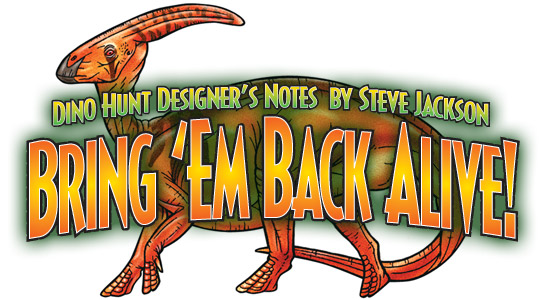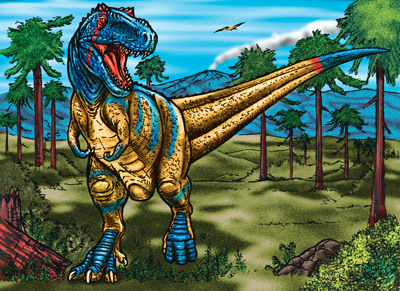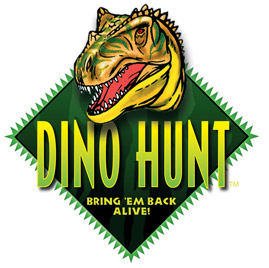
I'm a dinosaur nut. Always have been. When I was little, I was one of those kids who collects plastic dinosaurs and knows all the five-syllable names. For my birthday, I asked for dinosaur books. And, of course, I wanted to be a paleontologist when I grew up.
But somewhere along the line, the modern world took over. I went to college, and I started making games . . . and the closest I ever got to dinosaurs was museum visits. (Though there were a lot of those. When I got to a convention, a question I always ask is "Got any dinosaur museums around here?" I've gotten to do a lot of museum-crawling in the last few years.)
And for years and years, I've wanted to do a dinosaur game. I've even known what the game would be about, because it's one of my own favorite fantasies. Going back in time and hunting dinosaurs . . . not to take trophies, but to bring them back alive!
And that's what Dino Hunt is about.
It's intended for families . . . dino-loving kids, and their parents. So it's the simplest game I've ever designed. Let me tell you . . . it's not easy to design a simple game! The very first draft was playable, but it was far too complicated. Most of the playtesting for the next couple of months was "Okay, what's the next rule we can throw out?" The objective was to have a game where the turns went quickly and the whole game could easily be played in an hour . . . or much less.
Making It Real
I wanted the information in the game to be completely authentic. And that was a lot of work, but it was fun work. I had to buy a lot more dinosaur books (beat me, whip me, make me buy more dino books). In fact, one of the best things about Dino Hunt was getting to work with the "dinosaur professionals." The card artists, Pat Ortega and Bob Walters, are lucky people . . . they deal with dinosaurs every day. They have to stay up with the latest science, and it's all deductible!
Between mailing lists on the Internet, museum trips, and my visit last summer to Dinofest in Phoenix, I'm a bit closer to the "inside" of the dinosaur world. And that's fun. Also frustrating, when I get a piece of information that will be published next year . . . and means that I have to change a card now. But it's worth it.
And huge thanks go to our volunteer fact checkers, most notably Dr. Tom Holtz Jr. and paleo grad students Marion Anderson and Brian Curtice. They've all spent many hours reading cards, spotting errors, and helping me track down obscure dinosaur data. Why? Because they care about dinosaur science, and it matters to them that when kids play this game, everything they read on the cards will be true.
Who's It For?
 In marketing terms, the game is aimed in about four different directions, and we'll just have to see how many targets it hits. The first, of course, is "family game." We had dreams of placing it in the big chain stores, but they turned out to be just dreams . . . this year, anyway. But I think there's room for a family game in the "hobby" game stores, too. A lot of gamers have kids now, and maybe they'll appreciate a game that's simple enough for their kids to play, and rich enough that they can enjoy it too.
In marketing terms, the game is aimed in about four different directions, and we'll just have to see how many targets it hits. The first, of course, is "family game." We had dreams of placing it in the big chain stores, but they turned out to be just dreams . . . this year, anyway. But I think there's room for a family game in the "hobby" game stores, too. A lot of gamers have kids now, and maybe they'll appreciate a game that's simple enough for their kids to play, and rich enough that they can enjoy it too.
The second customer I'm thinking about is "kids who love dinosaurs." I know I would have loved Dino Hunt when I was 10. Not just for the game . . . not even mainly for the game. For the cards. Each box has 109 large, full-color cards, with beautiful, scientifically accurate pictures of different prehistoric animals. The back of each dinosaur card includes lots of information about that species . . . what it ate, the meaning and pronunciation of its name, as well as size, habitat, and interesting facts. I did my best to make this readable, but I don't "talk down" to the bright kids who will be looking at them!
The third customer is the card collector. This is a beautiful set of cards, with great art and up-to-date information. The 240 cards include ten ultra-rare gold foil "chase" cards. And the cards in the booster packs are a genuine limited edition, gold-bordered, dated on the back, appearing this year only. By all rights, this should be the kind of thing that appeals to the serious card collector. We'll see.
(Note, by the way, that Dino Hunt is a single-deck game . . . everybody plays from the same stack of cards. So you can't buy a victory. If you are buying cards to play with, the only reason to get them all is to have more variety for your game. You don't have to buy any boosters if you don't want to.) Finally, everybody who looks at this game tells me that it's a natural for the educational market. It plays quickly, and it has a lot of information in it. Kids want to learn about dinosaurs, and with this game, they get the most up-to-date facts.
Demo Hunt
We made up some beautiful (and expensive) prototypes of the cards and other components, and took them to the GAMA show. And what do you know . . . people wanted to play! They came to our booth and played standing up . . . they borrowed the game and took it to their own booths . . . they played it in the bar after hours. That seems like a Good Sign.
And the game was so easy to teach that we decided to try something new. We printed up several thousand copies of a cut-down version: 2 players, only 30 cards. It's purely a demonstration edition – thus, Demo Hunt. These went out to distributors last month, for them to pass along to their retailers. The theory is that if somebody is interested in Dino Hunt, the retailer can show them how the game works in 5 minutes on the store counter. (Yes, it's that simple; basically, there are only two game mechanics.) If they like it, they buy. If they don't like it, well, so it goes.
As I write this, we're just beginning to get feedback on Demo Hunt. It's good, so far. Cross your fingers.
What's Next?
 Now we finish the printing, ship it out, and see whether people like it. I hope so, not just because we've tied up a lot of money in it, but because it is a project I've wanted to do for so long.
Now we finish the printing, ship it out, and see whether people like it. I hope so, not just because we've tied up a lot of money in it, but because it is a project I've wanted to do for so long.
If it's really successful, I want to make it a continuing thing. A lot of people have suggested an "Ice Age" supplement . . . and while that name is already taken, I'd love to do a set of cards for mammoths, sabertooths and so on.
But most of all, I'd like to release a new edition of the dinosaur cards every year, with new art and updated information. And new dinosaurs are being discovered all the time . . . a new species every seven weeks, according to those who keep track. Some of these are really exciting, too! You can bet that a 1997 set would include new discoveries like the huge, shark-toothed Carcharondontosaurus and the speedy predator Deltadromeus. And who knows what they'll dig up next week?












